In 1905 Colt introduced the Police Positive revolver; it had a positive-lock action that kept the firing pin from striking the primer of a chambered cartridge unless the trigger was deliberately pulled. It was chambered in .38 S&W and .32 Long. Two years later, the frame and cylinder were lengthened, allowing it to be chambered in .38 Special and .32-20 WCF. This version became the Police Positive Special (PPS) and it began a series of D-frame revolvers that included the well-known Detective Special. The PPS was redesigned in 1977 and the barrel was given an underlug to protect the ejector rod, plus new walnut stocks were added. An aluminum frame variation called the Viper was produced, but was only made in 1977. With sales lagging, the PPS was discontinued in 1995.
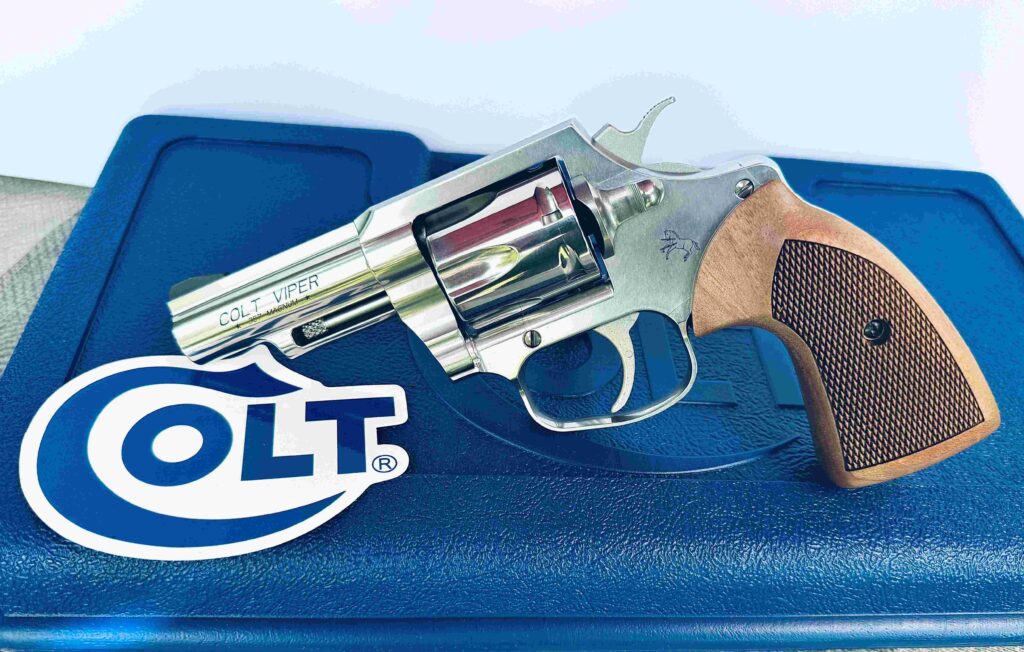
The new Colt Viper traces its lineage back to the Police Positive Special that debuted in 1907; instead of a .38 Special, it’s chambered in .357 Magnum.
The Viper Returns
In 2017 Colt redesigned and beefed up the D-frame revolver in .38 Special; it had a 2” barrel, was crafted from stainless steel, and they called it the Cobra. Next, Colt added the King Cobra series, which had fixed sights and 2” or 3”, full-lug barrels, in .357 Magnum. A Target version was later produced in .357 and .22LR, with adjustable sights and 4.25” barrels. Now Colt has resurrected the PPS, but made it of forged stainless-steel, with a 6-shot cylinder, fixed sights, and chambered in .357 Magnum. They call it the Viper. It can be had with a 3” or 4.25” heavy barrel that has a half-lug to protect the ejector rod, and checkered walnut stocks, like those on the original Viper.
To me, the 3” barrel revolver is very versatile and can be used for both on and off-duty carry. I packed a 3” sixgun in .357 Magnum as a LEO for several years. Stands to reason that I requested a 3-inch version of the Viper for testing. The sample gun came in a Colt blue plastic carrying case, with a foam-rubber padded interior, owner’s manual, and safety padlock. I examined the Viper finding it had excellent metal-to-metal and wood-to-metal fit, with no tool marks on the polished, stainless-steel finish. A matte finish was given to the top of the barrel rib and frame top-strap. Like the Colt Agent from years back, the Viper has a short grip frame. The walnut stocks extend almost an inch below the frame. They’re nicely checkered, but have a light coloration, and little wood grain.
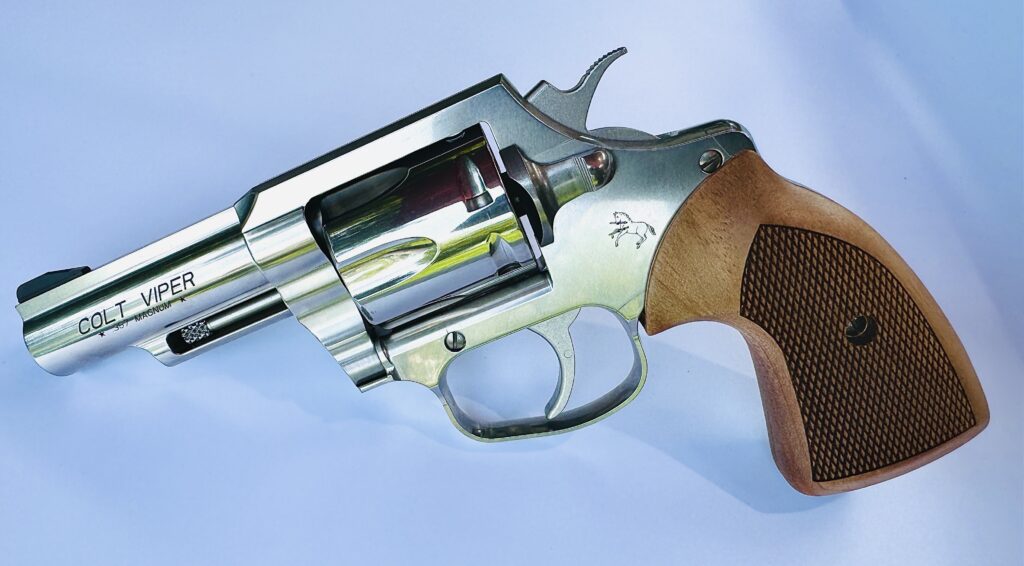
The new Colt Viper traces its lineage back to the Police Positive Special that debuted in 1907; instead of a .38 Special, it’s chambered in .357 Magnum.
The Vipers front sight is a black, serrated ramp, which is held in place by a tiny torque-screw. Its square-notch rear sight is 0.15” wide, providing a good sight picture. The heavy barrel has 1:14” LH, 6-groove rifling, and a recessed muzzle crown. Due to the 3-inch barrel, it has a full-length ejector rod, that is checkered at the tip. The reinforced frame has a thick top-strap that will allow a steady diet of .357 Magnum cartridges. The cylinder rotates clock-wise, is fluted, and chamfered on the front edges between the flutes. Pulling backward on the cylinder release latch frees the cylinder to swing out to the left for loading. The hammer spur is serrated and the 0.25” wide trigger is smooth-faced. The single action (SA) trigger pull weight averaged 4 lbs. 1.9 oz., with no creep; while the DA pull weighed 8 lbs. 13.5 oz., was non-stacking, and smooth. This outstanding action is owing to the guns double-leaf V-spring.
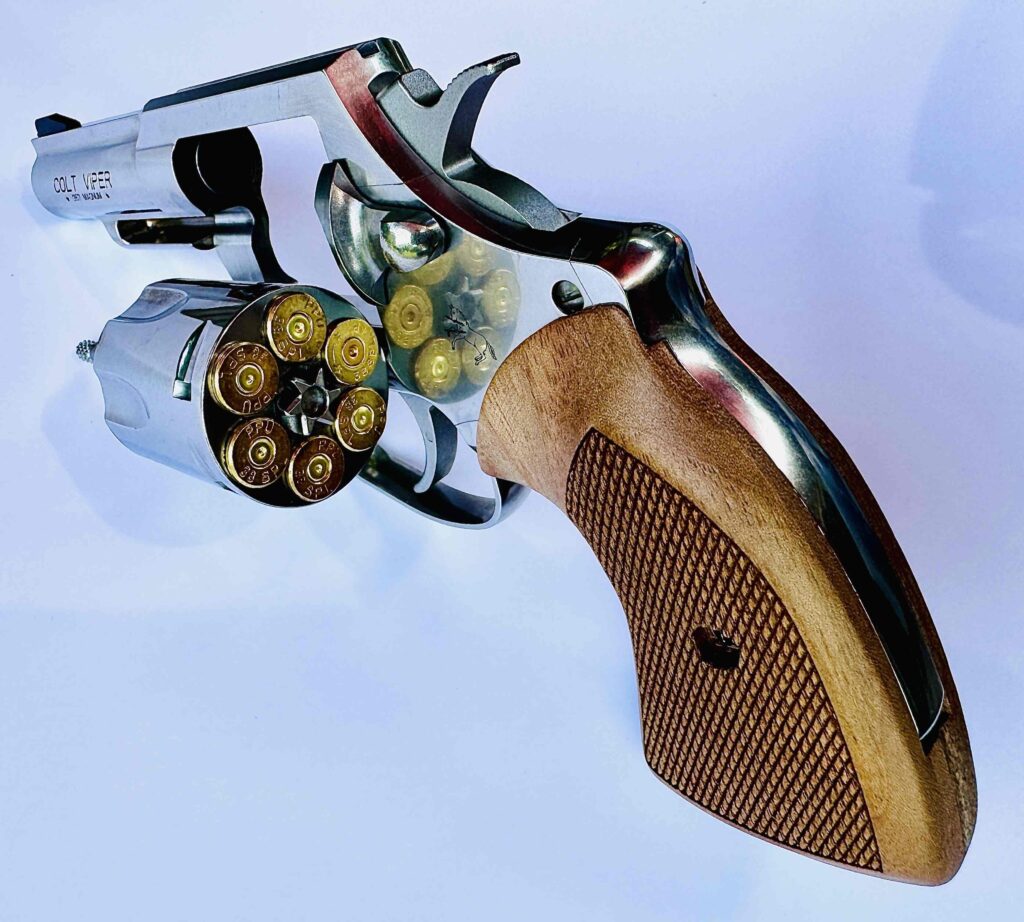
Colt originated the swing-out cylinder revolver; note the rounded knob on the cylinder release latch, it never touched the author’s hand, even shooting Magnums.
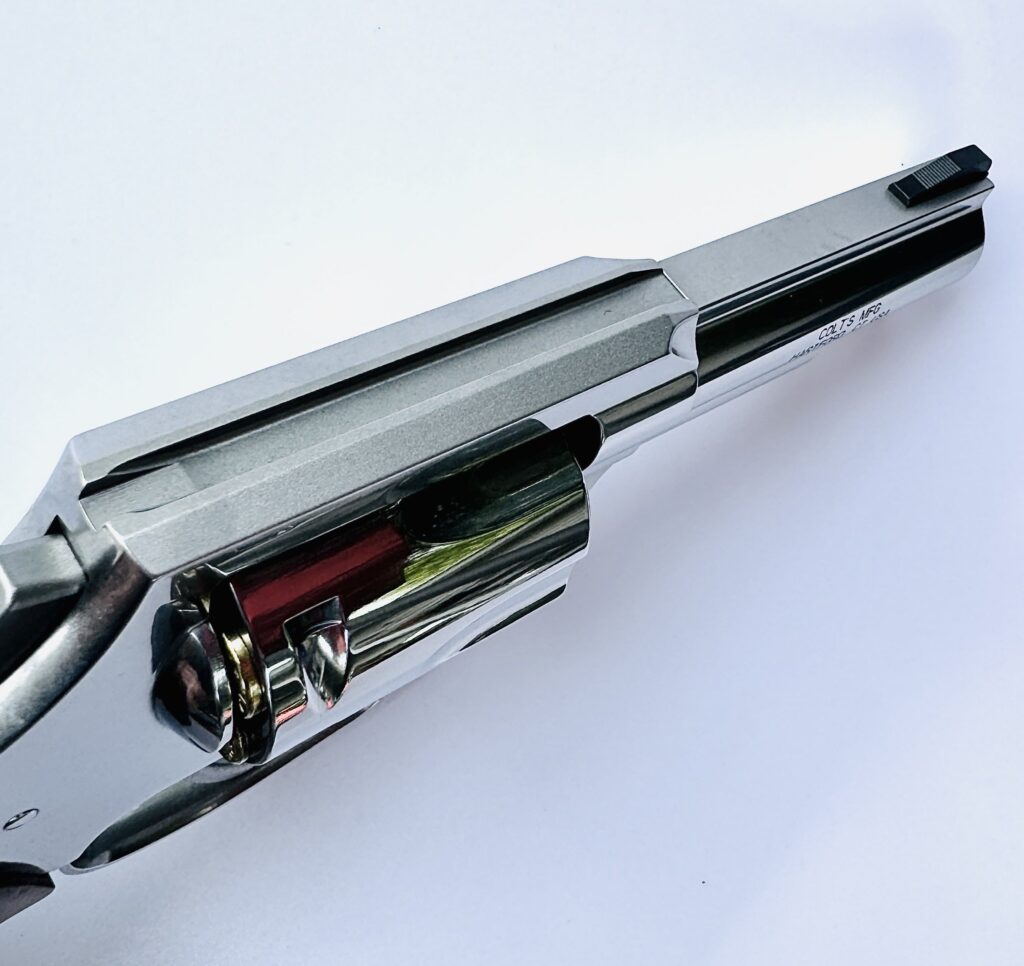
The rear sight on the Viper is a fixed square notch; the front sight is a ramp-type, serrated and black in color.
Gearing-Up for the Shooting Session
I planned to shoot both .357 Magnum, plus standard velocity and +P .38 Special loads, as the Viper has an empty weight of 26.9 oz. I decided to use Black Hills Factory New .38 Special +P ammo with a 125 gr. JHP bullet; Doubletap’s .357 Magnum cartridges, loaded with a 110 gr. solid-copper HP bullet; then Federal’s Train + Protect .357 Magnum load that has a “Versatile” 125 gr. JHP bullet. A standard-pressure .38 Special load came from PPU in Serbia, and has a 158 gr. LRN bullet; plus I selected Remington’s .38 Special HTP +P ammo that has their 125 gr. semi-jacketed (scalloped) HP bullets.
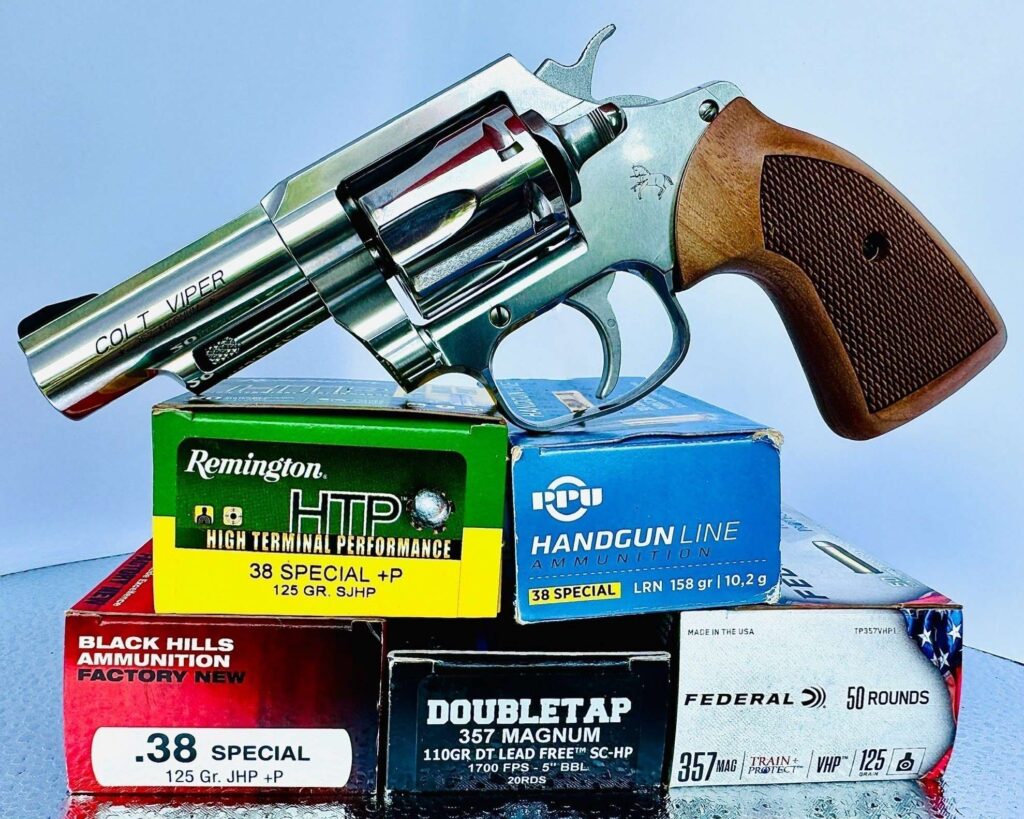
Two .38 Special +P loads, one standard-pressure .38 Special load, and two .357 Magnum loads were used to evaluate the performance of the Viper.
For the practical shooting part of the T&E, I needed carrying leather, so I picked a much-used Sourdough Pancake holster from Simply Rugged Holsters. This rig rides high on the belt, is an open-top style, with three belt slots, and fitted to the Colt D-frame. It’s tan in color with custom stamping depicting the Rampant Colt logo. For reloading, I used an HKS Model 10-A speedloader, carried in a Barranti Spare leather speedloader pouch. It’s also an open-top design, with two 1.5” belt slots, in brown finish.
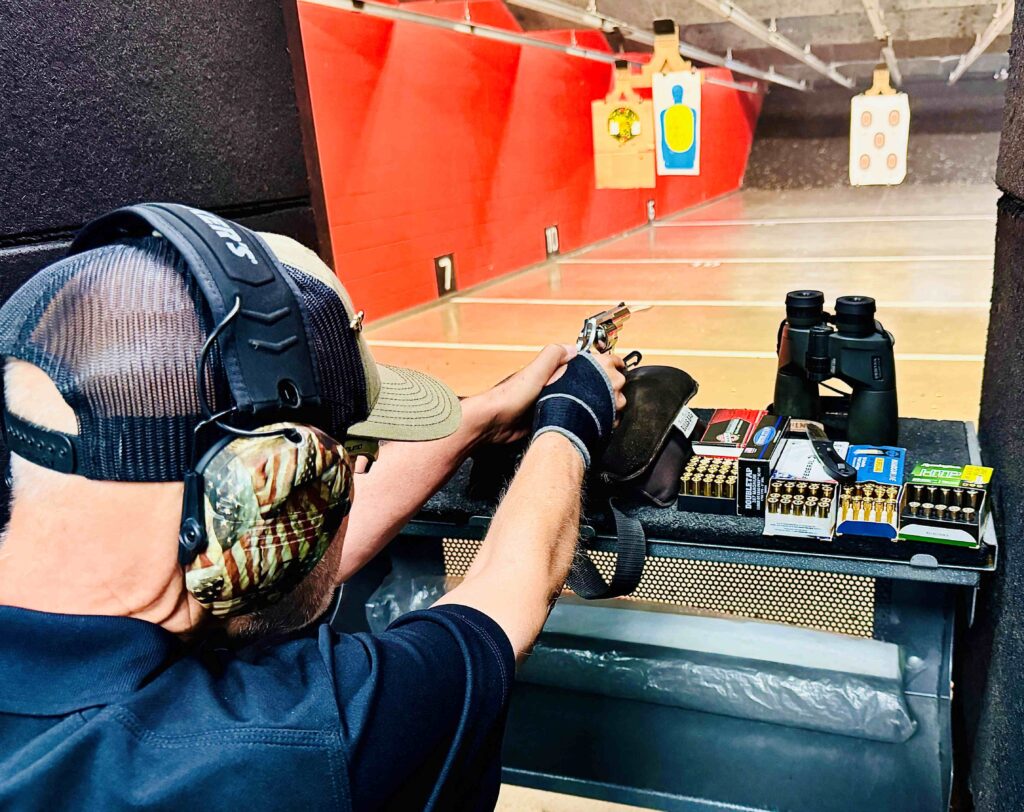
Accuracy potential testing was performed at 12 yards; shooting was done single action, from the bench, using a sandbag rest.
If there’s a feature on the new Viper that I take issue with, it would be the walnut stocks. When I first picked up the Viper, I knew that they would make shooting painful, the way my middle finger was pressed against the trigger guard. It only took a few Magnum and +P shots to confirm this. Fortunately, Badger Custom Grips came to the rescue with their Cobra/King Cobra Full Grip stocks. They’re two-piece, combat-type, with finger grooves, and palm swells that taper down to the butt. My sample were laminated wood in Spectra-Ply Blue Angel coloration; they fit my medium-sized hand perfectly, and solved the battered finger issue.
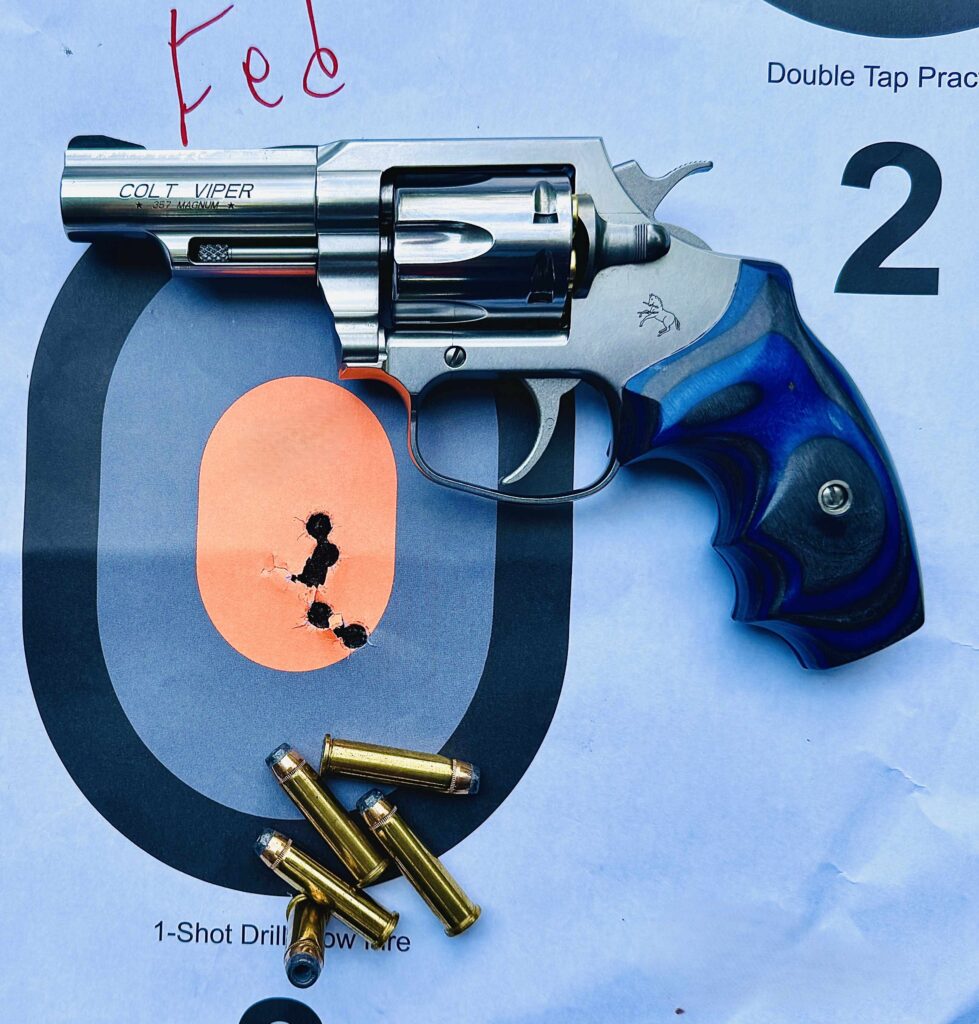
The best 5-shot group measured 1.17” and was made using the Federal Train + Protect .357 Magnum load; three groups were shot with each test cartridge.
Shots Fired
I discovered during the chronographing session (see performance table) that the Doubletap DT Lead Free SC-HP .357 load exhibited high-pressure signs with flat primers, and swollen cases. Extraction of the cases took some effort; not something I’d want to find out in a lethal-force situation. This condition continued during the accuracy evaluation. The best place to find out something like this is on the range, not on the street!
I decided to test the Vipers accuracy potential at 12 yards, given its barrel length and sights. Shooting was done SA, from the bench, using a sandbag rest. Three 5-shot groups were fired with each of the 5 test loads. Surprisingly, the tightest 5-shot group was made using the Federal Train + Protect .357 Magnum cartridges; it measured 1.17” with a group average of 1.66.” Considering bullet weight and velocity differences, point of aim/point of impact was good for most part. I generally held the top of the front sight almost even with the top of the orange center of the paper target.
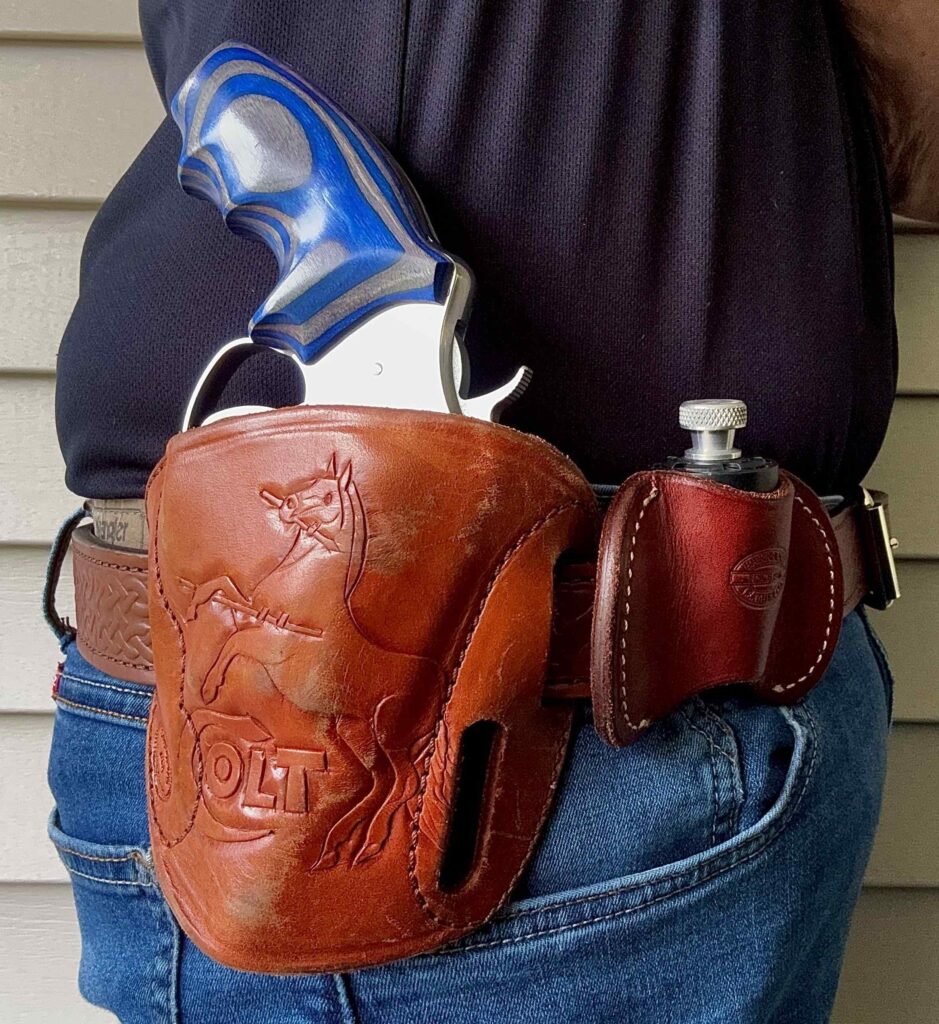
For the “Super Revolver” practical shooting drill, the author used a Simply Rugged Sourdough holster, Barranti Spare pouch, HKS Speedloader, and Badger grips.
OK, I’m an old guy that has been shooting handguns for over a half-century. After the velocity measurements were taken, and the bullseye shooting session concluded, my right hand, wrist and forearm just weren’t up to an extended practical shooting exercise. My iPhone has a number of shooting courses I’ve filed away, so I took a look at them. I decided on the “Super Revolver Test,” which I modified somewhat. It only requires 18 rounds and I elected to use the mild-shooting PPU .38 Special ammunition. The round-nose bullets also work well when using speedloaders. I loaded the Viper, seated it in my Simply Rugged holster, loaded the HKS speedloader and secured it in my Barranti pouch. The target was an anatomically correct, reduced-size human silhouette, with 7, 8, 9, and 10X scoring rings. This is a timed drill, so I used the stopwatch app on my iPhone.
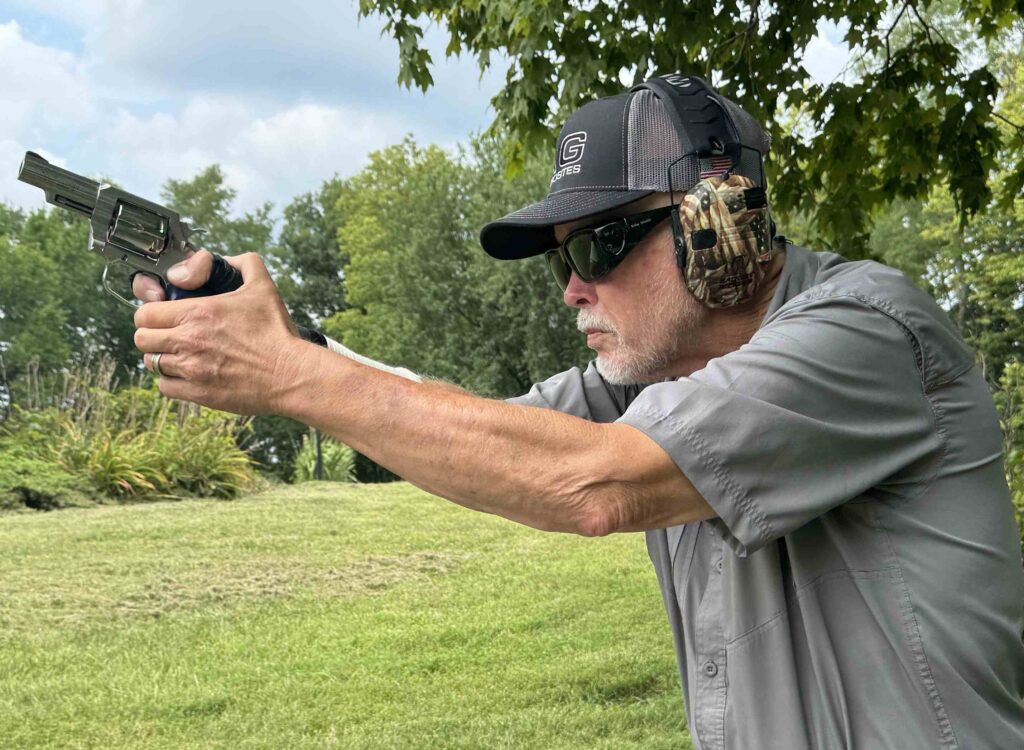
During the practical stage of the test, shooting was done double action, using a two-handed hold, and isosceles stance.
I elected to start each stage with the Viper in the holster and reloaded with the HKS speedloader at the end of each stage. Once the reload was completed, the target was kept under observation; the gun held at high ready, during the threat assessment, and then the gun re-holstered. I used a two-handed hold, sights, and an isosceles stance for all 3 drills. Stage one was at 5 yards, with 6 shots in 4 seconds, stage two was at 10 yards, with 6 shots in 8 seconds. Stage 3 was at 15 yards, with 6 shots in 12 seconds. All shooting was double action only.
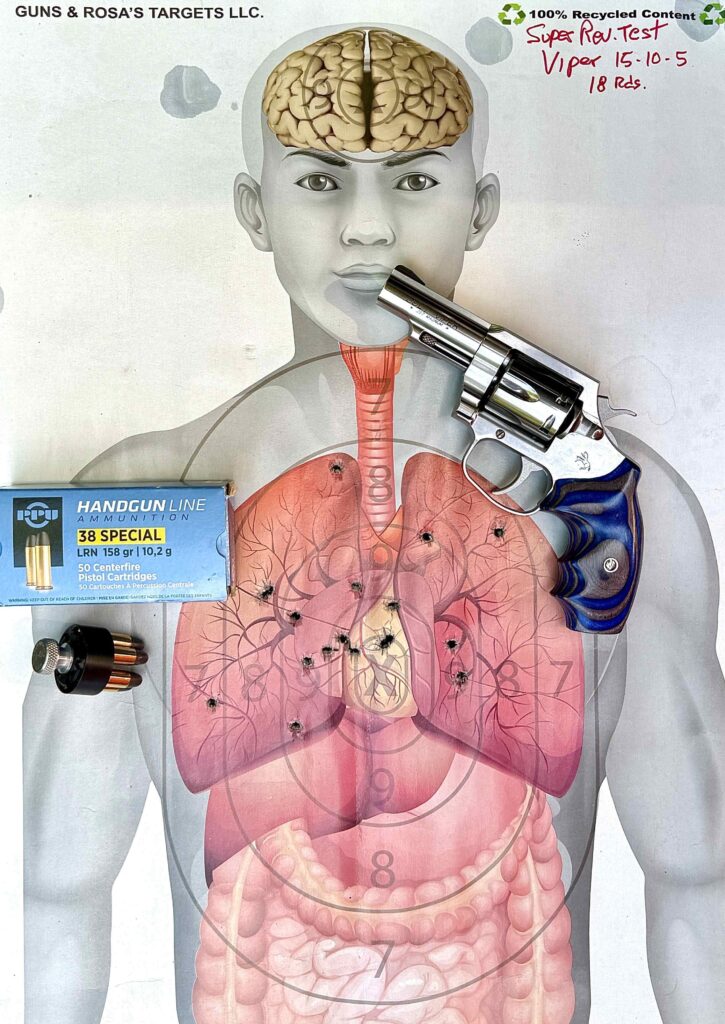
For the drill an anatomically-correct human silhouette target was used; possible on the timed course was 180 points, the author scored 161 using the PPU ammo.
Just the Facts
To my great satisfaction, I made the time limits on all three stages. Possible for the drill was 180 points. According to the instructions, passing is 90% or 162/180. My score was 161 with 3 X’s. Good-nuff! I found the sights were easy to acquire quickly, and I had no hiccups during the fast reloads. There were no malfunctions or issues attributable to the Viper during the T&E. Hats off to the Badger Custom Grips, plus honorable mention to the nice rounded cylinder release latch on the Colt; my right hand came away unscathed during the shooting sessions. I cut my teeth on revolvers, they’re simple to operate and maintain. When asked to recommend a handgun for a beginner, I usually prescribe a DA revolver. That said, the new Colt Viper would most certainly rate highly on my list for recommendation.
Additional Information
Colt Manufacturing LLC www.colt.com
Badger Custom Grips www.badgercustomgrips.com
Simply Rugged Holsters www.simplyrugged.com
Barranti Leather Co. www.barrantileather.com
Colt Viper Specifications
MECHANISM: Traditional DA/SA revolver
CALIBER: .357 Magnum/.38 Special +P
CAPACITY: 6 cartridges
BARREL: 3” (4.25” also available)
OA LENGTH: 7.92”
EMPTY WEIGHT: 26.9 oz.
SIGHTS: Black ramp front, fixed rear square-notch
FINISH: Stainless steel
STOCKS: Checkered two-piece walnut
MSRP: $999.00
Colt Viper Performance Table
| Cartridge | Ave. Velocity | Best Grp. | Ave. Grp. | Ft-Pounds Muzzle Energy |
| Black Hills Factory New .38 Special +P 125 gr. JHP | 938 FPS | 1.25” | 2.03” | 244 FPE |
| Doubletap Ammunition .357 Mag. 110 gr. Lead-Free SC-HP | 1557 FPS | 1.89” | 2.80” | 592 FPE |
| Federal Train + Protect .357 Mag. 125 gr. V-JHP | 1299 FPS | 1.17” | 1.66” | 468 FPE |
| PPU Handgun Line .38 Special 158 gr. RNL | 780 FPS | 2.33” | 2.68” | 214 FPE |
| Remington HTP .38 Special +P 125 gr. Semi-JHP | 1004 FPS | 2.24” | 2.41” | 280 FPE |
NOTE: Bullet weight measured in grains, velocity in feet per second 10 ft. from the muzzle by an Oehler Model 35P chronograph, and accuracy in inches for three 5-shot groups at 12 yards. FPE based on bullet weight and velocity.
To locate a dealer near you visit www.lipseys.com/dealerfinder
